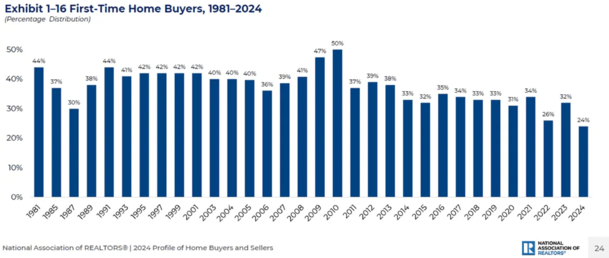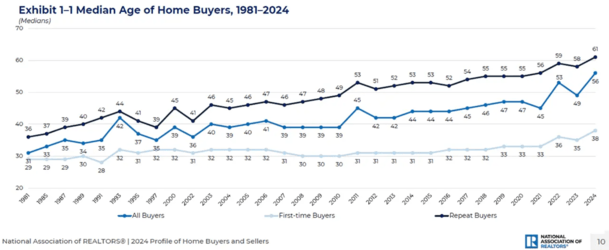The National Association of Realtors (NAR) reported that the share of first-time home buyers has fallen to an all-time low of just 24%.
This figure is down from 32% recorded a year earlier, based on transactions carried out between July 2023 and June 2024.
At the same time, the typical age of a home buyer has reached an all-time high of 56.
All of this speaks to a housing market that is becoming increasingly unaffordable, particularly for renters and young people.
But there is a glimmer of hope; we’re not seeing a flood of questionable home purchases like we did in the early 2000s.
Improved underwriting standards prevent subprime home sales

I’ll start by saying that the data is clearly negative.
These statistics from NAR certainly don’t paint a pretty picture of the real estate market at the moment.
FTHB stock reached a record level 24% in 2024, since 1981. And this is well below the historical norm of 40% before 2008.
This is a sign that housing has become unaffordable for most, especially those who have never owned one before.
Without a significant amount of proceeds from the sale (think buyers who already own), it is difficult to raise the necessary down payment.
And without a big salary, it’s almost impossible to afford the monthly payment at current prices.
So obviously not great if you’re a young person or a renter without a parent willing to offer you a deposit. Or co-sign your mortgage.
Compare this to the early 2000s, when we had similar conditions in terms of housing affordability.
At the time, instead of home sales slowing, they continued to rise thanks to things like stated-income loans and ARM payment options.
So while we might complain about affordability, we could also arguably be glad that home sales have slowed at a time when buying them may not be ideal.
Of course, this is not ideal for those working in the industry nor for potential home buyers, especially first-time home buyers.
But it would be even worse if sales continued to grow when perhaps they shouldn’t.
Imagine if we continued to approve everyone for a mortgage

Although fewer FTHBs are entering homes, the typical age of homebuyers has never been higher.
It rose to 56 for all buyers, 38 for FTHBs and 56 for regular buyers, all records!
In the early 2000s, we saw considerable sales volume as housing prices were near their peak.
The reason property prices continued to rise and sales continued to rise was because exotic financing was ubiquitous.
Back in the day, you could get approved for a home loan with just a credit score.
It doesn’t matter if you can’t document your income or make a down payment. Or if you didn’t have any money in the bank.
And once you’re approved, there’s a good chance they’ll give you an adjustable rate mortgage that wasn’t exactly affordable.
Or a 40-year mortgage or something else that isn’t sustainable or conducive to success as a homeowner. And after just a few months, chances were you’d already defaulted.
From this point of view, the slowdown in home sales therefore constitutes a healthy and natural reaction.
If they continued to progress with affordability as bad as it is today, it would be much more worrying. Instead, sales came to a grinding halt.
The housing market resets naturally
All the data really tells us is that the housing market is resetting. And this is a sign that property prices need to fall. Or maybe mortgage rates need to go down. Or wages must increase.
Or maybe a combination of all three.
It’s okay if we see a period of slowing home sales.
This tells us that something needs to change. All is not well in the real estate market. Or maybe even the economy.
This is arguably better than forcing home sales to continue with creative financing. And find ourselves in the same mess we found ourselves in over a decade ago.
I’m already reading calls to reinstate subprime lending, including a proposal for a no-down FHA loan.
It’s already only a minimum down payment of 3.5%, and they want to bring it down to zero.
Maybe instead we need sellers to be more reasonable. Or maybe we need to build more housing.
But forcing more sales with new, flexible forms of financing seems like an all-too-familiar path that we don’t want to take again.